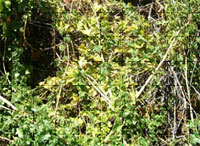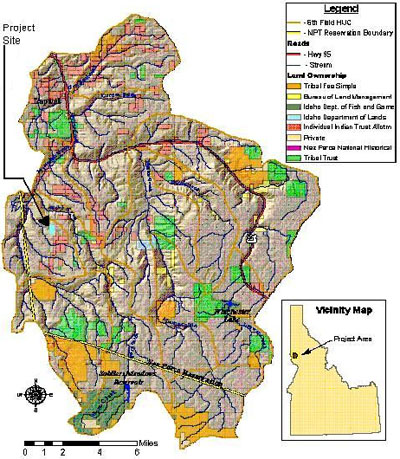 This demonstration project was conducted on one site in the Lapwai Creek watershed. This project concluded in 2006 and resulted in the identification of root cutting as the most effective control method.
This demonstration project was conducted on one site in the Lapwai Creek watershed. This project concluded in 2006 and resulted in the identification of root cutting as the most effective control method.
The demonstration project was completed in order to identify the best treatment method for controlling white bryony within the watershed. White bryony is mostly found infesting hawthorn groves near spring sources. Control efforts are necessary to maintain the hawthorn stands.

A stream inventory conducted in 2003 indicated a lack of riparian vegetation was contributing to the habitat limitations. These limitations include poor in stream cover (from lack of woody debris), high water temperatures (lack of vegetation to provide shade), low summer flows (low organic matter in banks to store water) and sediment (lack of root mass in stream banks to prevent erosion). Weeds are a major concern in the ability to establish riparian vegetation. One of the weeds identified is white bryony shown in the image above. The extent of white bryony in the watershed is unknown.
However, the control of this weed is necessary prior to restoration activities. The demonstration project was developed to identify treatment methods and educate landowners. The treatment site is located within the Lapwai Creek watershed in Nez Perce County, the site is in bottomland area with intermittent water (see location image). Adjacent land uses are cropland.
Five treatments were selected and include a control (no treatment), 2,4-D wiped on root, glyphosate wiped on root, glyphosate sprayed onto leaves, and severing of the root.
Based on the results observed during the 2004 and 2005 field seasons, the severed root and foliar glyphosate treatments were the most effective control methods for white bryony plants, yielding 100% mortality. The drilled glyphosate and 2,4-D treatments were effective, with 97% and 94% mortality rates, respectively, although plant mortality was greater with the other treatments, excluding the control. Due to the increased mortality and decreased chemical costs, the severed root treatment is the most economical and effective control treatment used in this demonstration project. Although the foliar application yielded 100% mortality, the labor and chemical costs make it less efficient; the white bryony plants had to physically be removed from the nearby vegetation to reduce non-target impacts, thereby significantly increasing labor and cost. In the future, severing the plant root is recommended for control of white bryony plants.
White Bryony Control-Demonstration Project - 2006